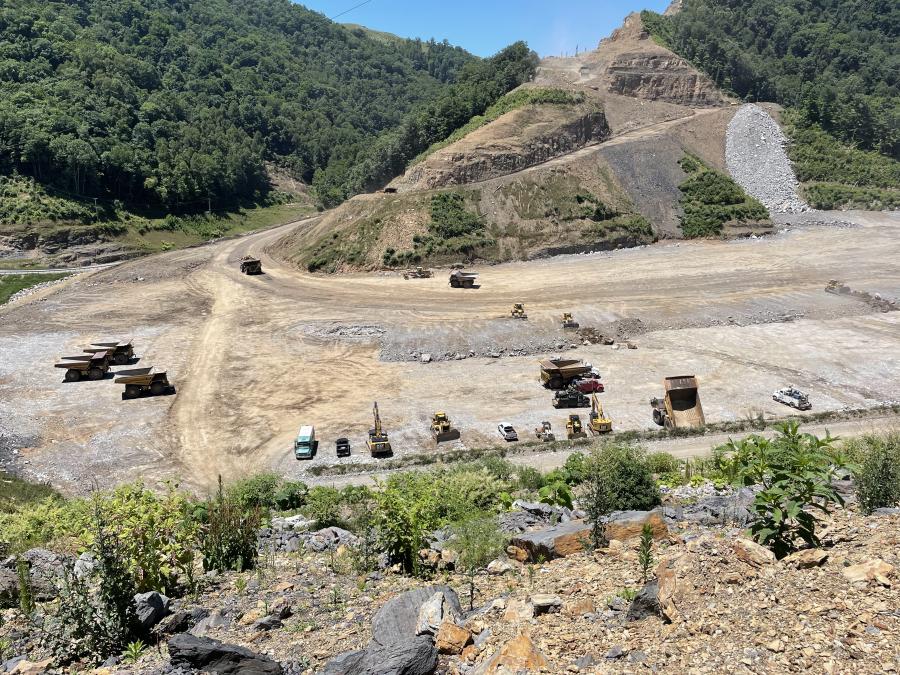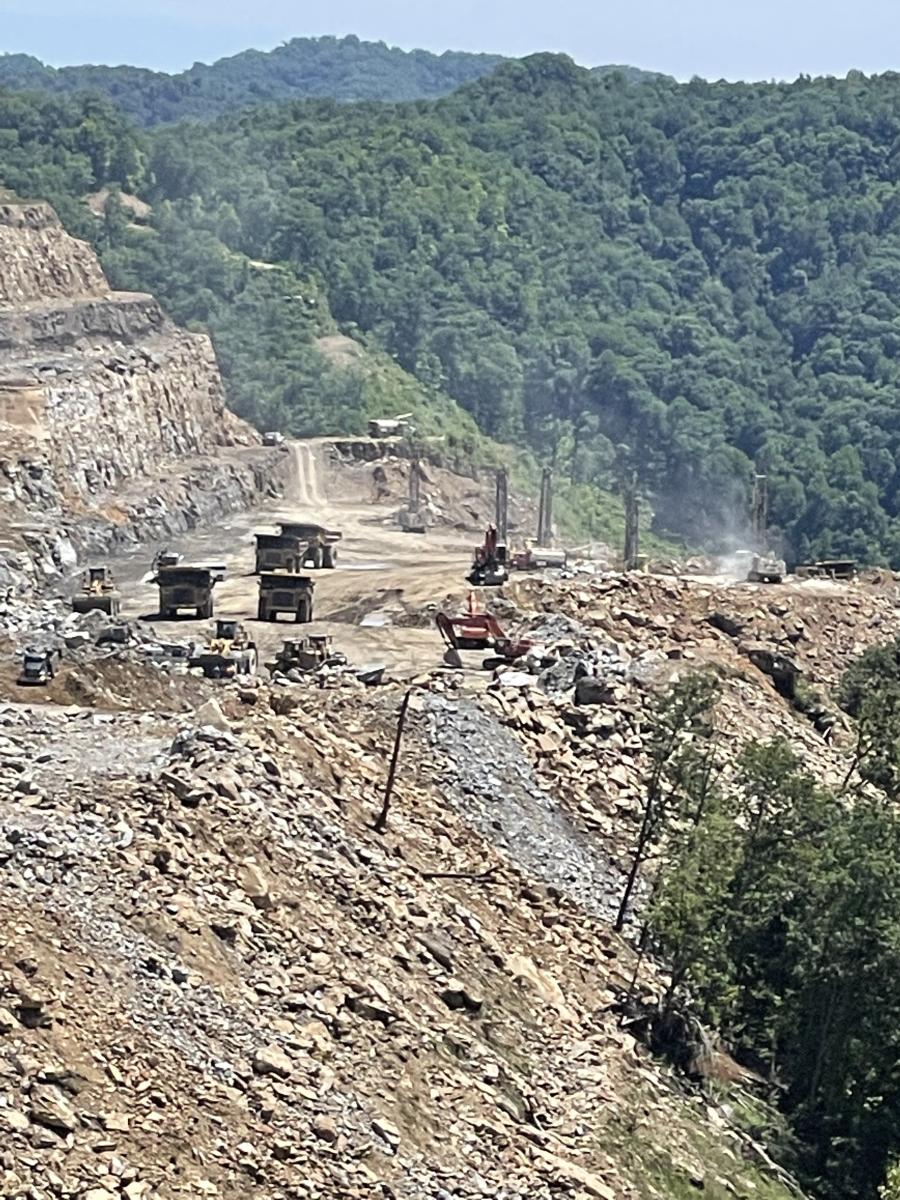On average, the contractors use 120 pieces of equipment on the project.
(Photo courtesy of Virginia DOT)
Virginia Department of Transportation (VDOT) is partnering with Bizzack Construction and subcontractors to build an updated road system that will improve regional connectivity and generate economic development in relatively isolated areas. Corridor Q (Route 460) will provide residents with better access to healthcare, improved travel times and increased interstate commerce opportunities.
Corridor Q will extend from the Kentucky state line to existing U.S. Route 460 in the town of Grundy, Va.
The massive undertaking means workers taking on many challenges including cutting through mountains and relocating the dirt and rock into support for the new highway. Corridor Q will provide a safer two-lane highway with truck climbing lanes. Workers will use large-scale equipment to move more than 15 million cu. yds. of material in just three years on a 2-mi. construction segment, Poplar Creek Phase B.
Corridor Q also has challenged engineers, field workers and planners alike as they built the tallest bridge in the state (Route 460 Connector Phase 1), will soon build the second tallest bridge in the state (Poplar Creek Phase B), built the deepest segmented, precast box culvert (Poplar Creek Phase A) in Virginia and will construct the deepest earth cut in the state (Poplar Creek Phase B).
This massive endeavor is composed of several smaller jobs, each of which would be a significant project on its own. The estimated cost for the entire 14.2-mi. project will be around $750 million.
- Route 460 Connector Phase I (approximately 1 mi.). Opened to traffic November 2020. Included construction of the tallest bridge in Virginia. Cost: $121 million.
- Route 460 Connector Phase II (approximately 6 mi.). Rough grade completed. Paved road will be open for traffic in late 2023. Cost: $194 million.
- Hawks Nest/Intersection (approximately 2 mi.). Rough grade completed. Paved road will be open for traffic in late 2023. Cost: $13 million.
- Poplar Creek Phase A (approximately 3 mi.). Construction under way. Completion expected in late 2024. Cost: $200 million.
- Poplar Creek Phase B (approximately 2 mi.). Includes a bridge over railroad/Levisa River, which will be the second tallest in Virginia. Completion date is mid-2027. Cost $220 million.
Marty Halloway, VDOT Bristol District Mega-Projects engineer, leads a team from various locations to coordinate these efforts.
"The current roads in this region are mountainous, two-lane roads," said Halloway. "Corridor Q will be safer with a significant reduction in travel time."
Blasting and drilling were vital to produce the deepest cut in the state, nearly 500 ft. deep.
"The Poplar Creek Phase A cut was the deepest cut, but only one of many necessary for this project," said Halloway. "Our contractor used large-scale equipment to move enormous amounts of material more quickly than would have been possible in the past. Work teams also used onsite material to create the embankments and fill."
The Corridor Q project required huge amounts of building materials including 35,000 tons of asphalt. Some 16,000 cu. yds. of concrete were necessary for just the Phase 1 bridge. An onsite concrete batch plant was used for the bridge. Workers planned to finish the pavement with a 6-in. base mix and 1.5-in. asphalt concrete pavement 12.5D surface. The roads will have 13-ft.-wide shoulders.
Tallest, Deepest
The Phase 1 bridge, the tallest in Virginia, was built over Grassy Creek.
"The bridge construction topped out at 250 feet above the creek," said Halloway.
The bridge was built of twin 1,700-ft.-long cast-in-place segmental bridges, each with a deck width of 43 ft., carrying two lanes of traffic in each direction.
Workers will take on another daunting challenge with the Poplar Creek Phase B project. When constructed, this will be the second-tallest bridge in the state at 150 ft. tall, just over 1,000 ft. long and containing a 338-ft. span.
Deep ravines created another problem for designers and workers. Stream impacts required some original thinking. The team solved the problem by building the longest segmented pre-cast box culvert in the state on the Poplar Creek Phase A project. The culvert needed to withstand 310 ft. of embankment fill on top of it and still be able to carry water to the proper channel.
"There was no template to use for designing such a culvert with that kind of stress and strain present," said Halloway. "Our team studied the various factors that would be on the culvert and made sure to design it properly. At one point we undercut an additional 25 feet of material to reach bedrock to make sure the culvert would be properly supported. Then, we put the temporarily relocated stream back into the box. We calculated that it would be sufficient to convey a 100-year flood, even while partially obstructed."
Not only did the team manage challenging geography, but communication was unique as the team was spread out from Maryland to Virginia and from Kentucky to Illinois.
"We had to rely on virtual collaboration and do much of the work virtually before and during the pandemic," said Halloway.
In addition, the teams had to contend with labor issues and supply chain challenges that are common in today's construction environment.
"We also had environmental challenges, utility schedules and permitting issues to work around."
Halloway is looking forward to the day when motorists will be able to use the new road in its entirety.
"In the end, I believe travel will be faster and safer. Travel will be much easier locally and to other states."
Equipment
On average, the contractors use 120 pieces of equipment on the Poplar Creek Phase A construction project at any given time. The Intersection Hawks Nest paving project has approximately 35 pieces of equipment. This includes everything from pickup trucks to large, off-road equipment.
- Caterpillar 777D and 785B haulers
- Caterpillar D8 through D11 dozers
- Caterpillar 980, 992 and 993 loaders
- Hitachi 1200 and 800 excavators
- Atlas Copco DM 45 drills
- Caterpillar 16G and 16H motor graders
- Metso mobile crusher and Extec portable screener
- Grove 5275 275-ton crane CEG
Chuck MacDonald
Chuck MacDonald is an editor, blogger and freelance feature writer whose writing adventures have taken him to 48 states and 10 countries. He has been the editor for magazines on pavement construction, chemicals, insurance and missions. Chuck enjoys bicycling, kayaking and reading. He graduated from the University of Missouri with a degree in journalism. Chuck lives in Annapolis, Md. with his wife Kristen. They have seven grandchildren.
https://www.linkedin.com/in/chuckmacdonald/ Read more from Chuck MacDonald here.
Today's top stories






















